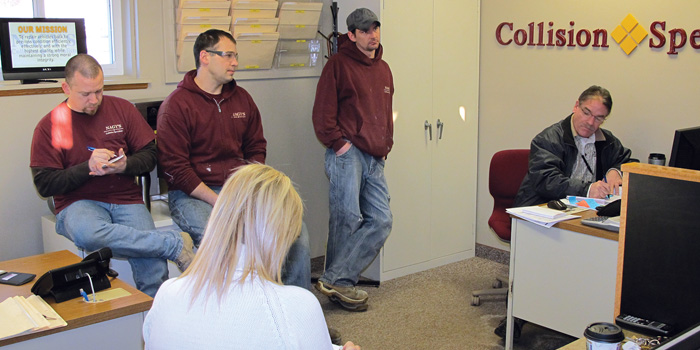Meetings sometimes stink. Most are long, some are boring, and others are downright unnecessary. You might walk into a meeting hoping to make a decision about a new safety concern or inform a group of employees about a new chemical, and walk out an hour later having accomplished nothing. In the meantime, you’ve facilitated a waste of time for an irritated group of people who won’t be signing up for your next meeting.
So is there ever a reason to hold another meeting? Absolutely! You just have to change up your methods a bit and focus on the task (or meeting) at hand.
Striving for Success
A successful safety meeting should be:
Purposeful. Arguably, the most important meetings in your shop are the ones that focus on the health and safety of everyone in your shop. But if you’re running a meeting, make sure it serves a purpose.
Define the scope of your meeting and prepare ahead of time by:
• Clarify the meeting’s goals, objectives and outcomes
• Identify who you want to invite (only those who need to be there)
• Predetermine the meeting time and location
• Build your meeting agenda, including any handouts
Let participants know ahead of time what will be discussed; this gives them the opportunity to come to the meeting prepared to give input.
If you’re running the meeting, be the first to arrive. Start the meeting on time and be respectful of your staff.
Consistent. Successful meetings are consistent. They start and end on time, and they’re scheduled at times that are most convenient for everyone. No one likes feeling that a meeting is cutting into their time and productivity, so if a meeting is scheduled for one hour, it should last one hour (or less). In every safety meeting, there should be consistent time allocated to both information and Q&A. Teamwork improves once information sharing becomes a consistent habit.
Results-oriented. Safety meetings should focus on outcomes, including problem-solving, informing staff about a new safety measure or process, or encouraging communication across the board. When they’re done right, meetings give employees a sense of ownership and belonging and make them feel like they’re
being heard.
Be sure to make good on what you’ve committed to do after the meeting. Discuss plans and a timeline to follow up on delegated or assigned tasks, and schedule a follow-up meeting if necessary.
Documented. Since documentation is essential when it comes to safety training, have your team members sign in to confirm attendance. If you ever get a visit from OSHA, you’ll have the information documented in writing or electronically. This also helps you with meeting follow-up because you know who was there and who
was absent.
Have a designated person take notes during the meeting. This helps with follow-up and accountability.
On the Other Hand
Avoid these common scenarios/habits when conducting safety meetings:
Being unprepared. If you aren’t prepared for the meeting, two things are bound to happen. First, you’ll lose your audience, and second, you’ll confirm what many people were already thinking: “This is a waste of my time.”
Ahead of time, encourage team members to bring thoughts and concerns to the meeting, and make sure you do the same. Meetings drag when no one is prepared. If you don’t think it’s important to prepare, why should they?
Boring attendees to death. Successful meetings keep people engaged and not reaching for their phones or another distraction. Don’t spend too much time on one topic. Keep things light and interesting, and encourage feedback and participation to keep attendees engaged.
For shorter meetings, have attendees stand. This keeps the group’s energy up and keeps things moving.
Complaint sessions. One of the biggest gripes from people who attend meetings is that they turn into complaint sessions. Heated arguing, browbeating, and people talking over each other have no place in a meeting. But it’s important to give each team member an opportunity to contribute.
Guide the meeting to make sure it goes smoothly, objectives are met and things get done. It’s frustrating to those in attendance to have the meeting hijacked by someone, especially when the meeting leader doesn’t do anything about it.
If things get out of hand, the leader should regain control. Any side conversations, personal gripes or specific complaints from one or more employees should be taken “off line” and handled separately. Don’t just push people off, though; make a plan to follow up and show employees you’re committed.
You’ve Got This
Not all meetings are terrible. Successful meetings require some degree of professional skill, as well as consistency, but anyone can learn how to do them well. When you know what’s expected of you as a leader and know how to run an effective meeting, your employees will walk away knowing that their time is valued.
Kyle Holt is the president of S/P2, an online safety and pollution prevention training system for the automotive, heavy-duty/diesel, welding, construction, cosmetology and culinary industries. He can be reached at [email protected].














